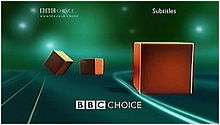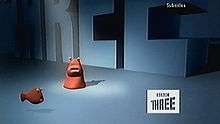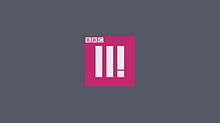BBC Three idents
BBC Three, and BBC Choice before it, have both had visually dynamic identities to appeal to the target audience of young adults.
BBC Choice
Choice of Three (1998–2000)
BBC Choice launched on 23 September 1998 as a digital channel aimed at the young adult market. Offering a choice of programming from specially commissioned programming to repeats from BBC One and Two. The launch identity was created by Lambie-Nairn and revolved around the idea of three objects, people, or characters with a central theme.[1][2] Five were made and focused on:
- Fan – a football fan, a hand fan and an electric fan.[1]
- Heart – a Heart of stone, represented by a heart carved out of stone, a light heart, represented by a heart shaped electric current, and Heartburn, represented by a burning heart shape.[1][2]
- Mouse – a mouse, a computer mouse and a clockwork mouse.[1][2]
- Punch – Mr. Punch from Punch and Judy, a punch represented by a boxing glove and Punch the drink.[1]
- Trumpet – a trumpet, the trumpet of a Daffodil and the call of an elephant, as seen by an elephant's trunk trumpeting.
In these idents, all three elements are seen individually close up before been seen together. The subjects are all seen on primary coloured backgrounds and feature a simple, one line logo below consisting of the BBC Logo and the name 'Choice' in upper case after the name in the font Gill Sans.[1][2]
Promotions also followed this form, with the BBC Choice logo at the bottom of the screen throughout the promotion and programme information appearing at the end in the Gill Sans font above the logo.[1] This style is the same as all of the BBC channels at the time. The station also utilised a Digital on-screen graphic (DOG) in the top left-hand corner of the screen, which featured the BBC Choice logo.[1]
For the first few years of the station's existence, regional variations for the BBC nations existed, although originally only between the hours of 10 pm and midnight.[1] Each region retained the individual idents, with the addition of the region name below the BBC Choice logo.[1][2] This allowed the nations to add additional programmes without disrupting the main schedules of BBC One and Two significantly. Notably, BBC Choice Northern Ireland utilised in-vision continuity prior to the idents, in which an announcer would appear in person to talk about the upcoming programmes.[1]
Single Heart (2000–2001)
On 10 July 2000, BBC Choice began to air programmes directly targeting the young adult audience, following an alteration to its remit. As a result, the original idents needed altering to match the new programming on the channel. The new idents built on the previous idea of the heart ident. The ident featured a single heart, usually the stone or fire heart, in the centre of a fluorescent background from which other hearts emanate. These include smaller hearts and an outlined heart 'beamed' out directly to the screen.[3]
The BBC Choice logotype was retained following the rebrand, as were promotion styles, the DOG and the national opt-outs for Scotland, Wales, and Northern Ireland. However, the concept of a rotating triangular prism featuring the words 'Now on Choice' on each of the sides was used in promotions and to showcase upcoming programmes.[4] The website address was added under the DOG in November 2000.
Three Boxes (2001–2002)

On 6 July 2001, BBC Choice rebranded again. This time, the hearts aspect was dropped in favour of three orange boxes set in a blue and green world.[1][5] The boxes would often interact with each other, roll over and adjust their own shape.[1][5] The BBC Choice logotype remained at the bottom of the screen throughout the idents and as the DOG, although the DOG was altered to add the BBC Choice URL below the logo.[1][5]
These boxes were used in many aspects throughout the channel, such as Now, Next and Later pointers to upcoming programmes.[6] The promotions also changed; the BBC Choice logo still remained at the bottom of the screen throughout the promotion, however information was now purveyed through the boxes.[1][6][7] As each detail, such as the programme title, day and time of broadcast, was announced, a box appeared in top right of the screen with the detail written next to it.[1][6][7] All three boxes were shown stacked atop each other in the top right of the screen at the end of the promotion.[1][6][7]
The channel at this time also started to change its format: a result of the BBC wanting to rebrand and reposition BBC Choice as BBC Three. All regional variations of the channel ceased and the channel was split into two distinctive segments: BBC Choice starting from 7 pm and CBBC on Choice from 6 am.[6]
Construction (2002–2003)
Following the approval of BBC Three by the government, the identity began to change to reflect the new channel coming soon. First of all seen were variations of the current idents within which a wrecking ball would hit the screen, causing it to shatter, revealing a building site behind it.[1]
In December 2002, the whole ident package changed outright to two builders on the construction site seen previously. Scaffolding and blue sheeting obscure the upper case 'THREE' that would provide the backdrop to the BBC Three launch idents. The builders themselves would often interact with elements of the identity, such as placing their mug of tea on the BBC Choice logo.[1] Over the Christmas period, the channel's first Christmas idents were created featuring a builder taking his hat off to reveal a pair of reindeer antlers against the construction site lit with lights round the scaffolding. On 19 January 2003, a countdown was added to the exterior of the scaffolding, outlining the weeks and days until the relaunch.[1]
BBC Three
Blobs (2003–2008)

BBC Three launched on 9 February 2003. The new identity for the channel was devised by Lambie-Nairn and featured 'blobs' set in a blue environment with a towering three-dimensional 'THREE' in the background.[8][9][10][11] The blobs were designed to be characters within the ident and not presenters and never commented on the upcoming programme.[10] Each blob was computer generated, created by Stefan Marjoram at Aardman Animations,[9] and given a voice from the BBC Sound Archive. The brown blobs parallel the CBBC green and CBeebies yellow blobs used at the time and showing a progression through age groups.
The channel's logo consisted of a BBC logo above a slanted, upper case, Three set inside a white box.[9][10] The contents of the box itself, however, were transparent, so that the ident could be seen through the logo.[9][10] The box structure itself is similar to the other BBC Channels, but the slanted text is different from all of the other channels, who at the time had the channel name in Gill Sans below the BBC logo. In 2005, the box colour was changed from white to blue with white text.[9][11]
The channel's original DOG consisted of the style previously used on the BBC's channels, using the BBC logo follower by an upper case 'THREE' in the font Gill Sans.[9] This lasted until 2005, when it was replaced by a DOG proclaiming the channel as 'Channel of the Year' in upper case and in the same font as the BBC Three logo.[9] The BBC Three logo itself was adopted after this.[12]
The channel used a variety of promotions and stings. Prior to the launch, the channel made use of the song "Three Is the Magic Number",[9] based (only the lyrics are copied) upon Schoolhouse Rock! played in the background. Other trailer animations showed one blob standing in front of the figure 'THREE' shouting "Three!", before another 'THREE' rises up from underneath the original, toppling it.[13][14] Promotions originally ended with a gradient blue stripe over the programme promotion containing the information and BBC Three white logo; this was however changed with the logo to a three-dimensional blue block seen from a corner with programme information on one side.[9][14]
The channel occasionally used slides for continuity; one used each day at startup featured a still from one of the idents along with the simple message 'BBC Three gets going in a moment',[9][14], however, some were used to link to upcoming programmes. These slides featured the programme picture in the centre of the screen with the 'THREE' clearly visible behind it in the background with the BBC Three logo and programme information directly below the picture.[14]
According to The Guardian, the blobs were eventually replaced because viewers found them "cold and shouty".[15] Their departure was marked with special idents featuring celebrities such as Matt Lucas voicing the blobs.[15][16]
Media World (2008–2013)

In 2008, Danny Cohen, the controller for BBC Three at the time, unveiled a new cross-platform brand for BBC Three. The new logo would feature on the revamped BBC Three website, mobile site and on the channel itself. The links between the three media would only increase with time as emphasis was placed to watch the channel on all three platforms. "The thinking behind this rebrand of the channel is that we have, in effect, created a BBC Three world in which our content can move seamlessly between TV, online and mobile", he explained. "We have a fantastic line-up of programmes and we are going to make them available wherever young people want them."[17][18] The rebrand cost GBP 380,000, described as "relatively little" by Cohen.[15]
The look was designed by Red Bee Media[8] along with agencies MPG and Agency Republic with music and sound design by creative audio company Koink.[19] The idents themselves featured a new look BBC Three logo; a continuous pipe containing pink liquid spelling out 'three' in lower case below a BBC logo.[9][19] In the idents, the logo is seen on its own as an object in the 'Three world'. However, the logo is occasionally seen contained within a purple box for cross channel promotional purposes.[20]
The idents themselves contain a surreal world where technology is seen in large scale, with plug sockets, phones, televisions along with other objects such as fire extinguishers, sunglasses, high heeled shoes, lipstick all linked together by pipes containing multicoloured liquid.[9][19][21] Pools of this liquid is also seen in a number of the idents when pipes breach.[9][19][21] The plainly surreal nature of these scenes conveys the nature of the programmes themselves as they take a different view of life.
Following the 12 February 2008 relaunch, the channel began to use in-vision continuity, with announcers such as Jose Vanders announcing the upcoming schedule in the early evening.[9][22][23] In addition to this, members of the public could record and upload links into programmes shown in the late evening or alongside the announcer in the early evening.[22][23] This was however suspended in Summer 2008.[23]
The channel changed its DOG at the time of the relaunch to a full-colour version of the new logo, a controversial decision at the time.[9] The DOG was originally placed to the centre left of the screen so that viewers without a widescreen television would still be able to see the logo. However, in 2011, the DOG's of all BBC channels was moved to the far left corner of the screen.[24]
BBC Three's promotional style initially featured a scene of the 'Three world' at the conclusion of the promotion, containing the BBC Three logo, promotion information and a clip from the programme seen from a suspended television.[20][22] The end clip was dropped after a while however, with a plainer look utilised instead.[24] Programme slides are still utilised by the channel, however it is primarily used on other channels.[24] The slide design features a picture from the programme above the BBC Three logo and programme information contained within a purple box all inside a billboard design.[24]
Discovery (2013–2016)

The latest idents and presentation style was introduced on 1 October 2013, retaining the logo from 2008. The idents follow the theme of "discovery", and were designed by Claire Powell at Red Bee Media.[25] The soundtrack for the idents was composed by Chris Branch and Tom Haines at Brains & Hunch.[26]
Remix of BBC Three (2016)

On 4 January 2016, BBC Three got a new look, before the television channel moved to online only on 16 February.
References
- Walker, Hayden. "BBC Choice". TVARK: The Online Television Museum. Archived from the original on 1 April 2012. Retrieved 5 December 2011.
- "BBC Choice September 1998 – July 2000 Idents". The TV Room. Archived from the original on 2013-02-04. Retrieved 5 December 2011.
- "BBC Choice July 2000 - July 2001". The TV Room. Archived from the original on 2013-02-04. Retrieved 5 December 2011.
- "BBC Choice July 2000 - July 2001 Miscellaneous". The TV Room. Archived from the original on 2013-02-04. Retrieved 5 December 2011.
- "BBC Choice July 2001 - February 2003 Idents". The TV Room. Archived from the original on 2013-02-04. Retrieved 5 December 2011.
- "BBC Choice July 2001 - February 2003 Miscellaneous". The TV Room. Archived from the original on 2013-02-04. Retrieved 5 December 2011.
- Wood, Andrew. "Miscellaneous BBC". The Ident Gallery. Retrieved 5 December 2011.
- Lucas, Gavin (23 January 2008). "BBC Three – Rebranded". Creative Review. Archived from the original on 2012-10-12. Retrieved 2012-05-29.
- Walker, Hayden. "BBC Three". TVARK: The Online Television Museum. Archived from the original on 2012-05-06. Retrieved 5 December 2011. Contains videos of BBC Three presentation.
- "BBC Three February 2003 - February 2008 Idents". The TV Room. Archived from the original on 2013-02-04. Retrieved 5 December 2011.
- Wood, Andrew. "BBC Three 2003 Idents". The Ident Gallery. Retrieved 5 December 2011.
- "BBC Three February 2003 - February 2008 Promo 1". The TV Room. Archived from the original on 2012-07-18. Retrieved 5 December 2011. Contains example of DOG in corner of image
- "BBC Three February 2003 - February 2008 Promo 1". The TV Room. Archived from the original on 2012-07-18. Retrieved 5 December 2011. Contains example of promo as seen through progressive images.
- Wood, Andrew. "BBC Three 2003 Miscellaneous". The Ident Gallery. Retrieved 5 December 2011.
- Holmwood, Leigh (22 January 2008). "BBC3 says goodbye to its blobs". Guardian.
- "New BBC Three season - full details". British Comedy Guide. 22 January 2008.
- "BBC Three Winter/Spring 2008 Press Pack". BBC Press Office. Retrieved 31 July 2011.
- Welsh, James (Jan 22, 2008). "In Pictures: BBC Three's new idents". Digital Spy.
- "BBC Three February 2008 - Present Idents". The TV Room. Archived from the original on 2013-02-04. Retrieved 5 December 2011.
- "BBC Three February 2008 - Present Promotions". The TV Room. Archived from the original on 2013-02-04. Retrieved 5 December 2011.
- Wood, Andrew. "BBC Three Idents". The Ident Gallery. Retrieved 5 December 2011.
- Wood, Andrew. "BBC Three 2008 Miscellaneous". The Ident Gallery. Retrieved 5 December 2011.
- "BBC Three February 2008 - Present In vision continuity". The TV Room. Archived from the original on 2013-02-04. Retrieved 5 December 2011.
- Wood, Andrew. "BBC Three Current Miscellaneous". The Ident Gallery. Retrieved 5 December 2011.
- "BBC Three". Red Bee Media. October 2013. Archived from the original on 12 December 2013. Retrieved 16 November 2013.
- "BBC Three Idents". YouTube. Red Bee Media. 9 October 2013. Retrieved 16 November 2013.